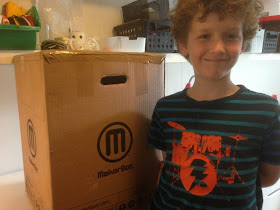The Mini was built to be easy, and as far as setup is concerned it definitely is, as Calvin will now demonstrate. The extruder snaps into place with a strong magnet:
Then you put the filament spool in the back, pull the filament through the tube, and seat the tube clip near the spool. Make sure your spool has the filament feeding from below into the clip:
Then insert the end of the filament into the top of the extruder:
Finally, snap in the build plate:
Once the printer is set up you have to install the MakerBot Desktop software. For those of you with pre-5th-gen machines, Desktop is different from MakerWare, and it's both more and less powerful at the same time: it's more powerful in the sense that it is connected to Thingiverse and a Library of your designs, but less powerful in the sense that there is a lot less flexibility with custom profiles and settings. The same is true of the machine itself: it's more powerful, has a better extruder, etc, but it's not made to be taken apart and repaired like the trusty Replicator 2 was.
Once you get Desktop installed, it is a good idea to immediately update your firmware. From the menu at the very top of the MakerBot Desktop screen choose Devices/Update Firmware, then download the firmware. The process takes a while and then the printer will restart. If you have a problem with your prints, the very first thing that Support is going to ask is whether or not you have updated your software and firmware, so you might as well do it now!
Here are some links to help you finish setting up and get started on your first print:
- MakerBot Getting Started pamphlet for the Mini
- MakerBot Mini Reference Guide
- MakerBot assembly video of the entire setup process
- Download site for the MakerBot Desktop software
- MakerBot Printshop app for creating a few easy prints from your iPad
To get started right away you can try one of the example files that come with the Mini: From the menu at the very top of your screen while in the Desktop software, look under File/Examples for various things that you can print. In tomorrow's post we'll have another recommended "first print" you can try.


